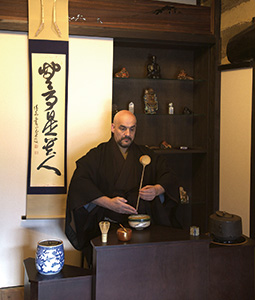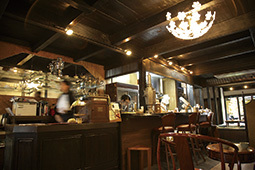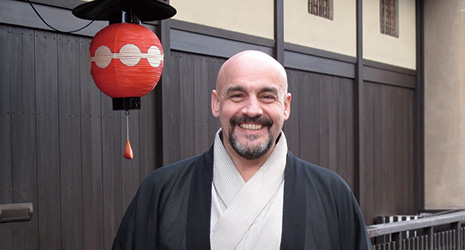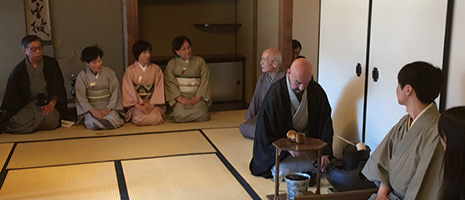
Channell making tea 
Channell’s café, ran Hotei, in Kyoto
January 2021
Spiritual Growth and the Way of Tea

Canadian Randy Channell traveled to Japan more than thirty years ago to study martial arts. He is now a master of chado (also known as sado, the way of tea) who goes by the name Soei.

“There is a phrase in tea, ichigo-ichie. It can be directly translated as ‘one term, one meeting’ though more commonly it’s understood as a once-in-a-lifetime encounter. It means to treasure the moment. This attitude of cherishing the present, which can never be repeated, is the same spirit that both the tea master and the guests embrace when attending a chaji (formal tea gathering) or chakai (informal tea gathering). I think sharing these ‘moments’ with people is one of the most appealing aspects of chado,” says Randy Channell Soei, professor of Urasenke, one of the main schools of chado.
After learning of the term bunbu-ryodo (union of cultural and martial ways) through kung fu in Hong Kong, Channell, who is Canadian, traveled to Japan to learn Japanese martial arts. Living in Matsumoto City, Nagano Prefecture, he spent his days practicing various martial arts including kendo (Japanese fencing), kyudo (Japanese archery), iaido (Japanese sword-drawing), naginata (Japanese glaive) and nito-ryu (two sword style kendo). He later relocated to Kyoto to begin serious studies in chado, and has now been living in Japan for over three decades.
The “way” (do in Japanese) that caught Channell’s interest represents a way of life that is not bound by the mere acquisition of skills or results such as winning or losing, but instead seeks spiritual growth through that process. In addition to martial arts, some traditional cultures and techniques are also referred to as geido (way of arts) and include the same do, such as kado (flower arrangement) and kodo (incense appreciation). Proficiency in both types is referred to as bunbu-ryodo, as described above. While studying martial arts in Matsumoto, Channell also began to practice chado, shodo (Japanese calligraphy) and the koto (Japanese harp). Of these, it was chado that particularly captured Channell’s heart.
“Interestingly there are many similarities in budo (martial arts) and chado, obvious ones being movement and posture. Say for example when I bring the mizusashi (water container) into the tearoom, or assume the middle fighting position in kendo, or begin raising the bow in kyudo, the shape of my upper body is basically the same. I’m well centered with my back straight and my arms rounded. The similarities extend beyond just the physical movements and postures as well. Like budo, tea is ‘steeped’ in Zen thought. There’s even a phrase, Cha Zen Ichimi, which could be translated as “Tea and Zen are of one flavor.” The Four Principles of Tea, wa (harmony), kei (respect), sei (purity) and jaku (tranquility), are ideals that can be shared by both,” explains Channell.

Channell moved to Kyoto in 1993 and began his formal studies in chado at the Urasenke Gakuen Professional College of Chado. He graduated the college in 1996 and was personally given the name Soei as a master of chado by the 15th Grand Tea Master of Urasenke in 1999. The name contains the character for sakaeru, which means to flourish or prosper, and expresses the hope for Channell’s long success.
Channell is currently based in Kyoto City where he teaches chado at Nashinoki Shrine, which is located on the east side of the Kyoto Imperial Palace. Many of his pupils are Japanese, he says. Inside the shrine is the Somei well, known as one of the three best sources of water in Kyoto. The slightly sweet and mild water from this well is said to be suited for the tea ceremony, and he uses this water to make tea.
Channell also runs the ran Hotei café in Kyoto. Based in a remodeled traditional townhouse more than 100 years old, the café serves fragrant and smoothly frothed matcha (powdered tea) and matcha sweets using his original matcha produced in Kyotanabe City. The café also offers tea ceremony experiences and tea gatherings that make it easy for those interested in the way of tea to take part. Essential to the hospitality offered at a tea gathering are the utensils used. From a collection accumulated over many years, Channell combines the utensils most befitting the theme of each gathering to delight his guests. At his café, the bowls used change each month so the guests can enjoy matcha even if they are unfamiliar with chado. Additionally, to ensure the entryway to the world of tea is always open, Channell also holds ryurei tea gatherings with tables and chairs so that people who have trouble kneeling on tatami mats and others new to the tea ceremony can easily attend, as part of his commitment to sharing the joy of tea.

“Chado doesn’t have to be difficult. You can start by simply enjoying the tea as a guest. As you gradually learn the spirit behind it, you can begin to understand how deep it is. There is no destination along this ‘way,’ it’s the journey. Even though I am a ‘tea master’ I feel I must continue to study and practice. That’s another appealing facet of the way of tea,” says Channell, whose smile captures the joy that chado and its once-in-a-lifetime encounters have brought him.

